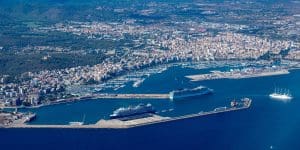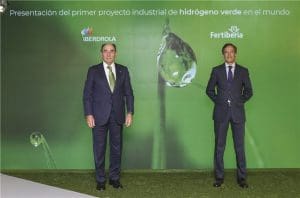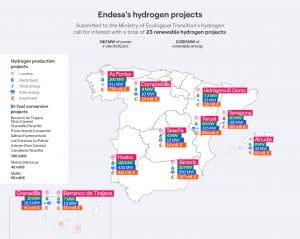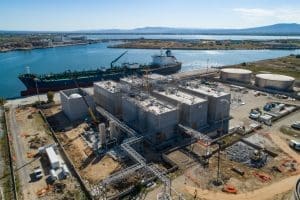On October 6, 2020, Spain’s Ministry For The Ecological Transition And The Demographic Challenge (MITECO) approved the “Hydrogen Roadmap: A Commitment To Renewable Hydrogen.” The hydrogen roadmap was the result of discussions between 78 public and private entities that believed it was important for the Spanish Government to play a role in the European Union’s Hydrogen Strategy. “Renewable hydrogen is one of the main energy vectors in the long term because its production and consumption is climate neutral and does not generate polluting emissions, with capacity to be stored as gas under pressure or in liquid state, which allows for a greater degree of manageability,” said MITECO. MITECO was founded in June 2018 as an independent department tasked with fighting climate change.

The EU’s Hydrogen Strategy is centered around embracing what’s commonly called the Hydrogen 2 or “H2” economy (which is a nod to the hydrogen portion of the water molecule). Put simply, H2 encompasses all of the use cases of hydrogen as a complement to natural gas and renewables. This includes hydrogen fuel cells, hydrogen vehicles, the use of hydrogen in energy storage, hydrogen boilers, and even the blending (up to 20%) of hydrogen into existing natural gas systems to reduce emissions.
Objectives Of The Hydrogen Roadmap
Spain has earmarked US$10.5 billion toward its Hydrogen Roadmap over the next 10 years. The majority of funds will come from the private sector with support from the public sector. Spain’s hydrogen pledge matches that of Germany, which is commonly regarded as Europe’s leader in hydrogen energy investment. Spain’s hydrogen budget is impressive considering Germany consumes substantially more energy, has a bigger population, and has an economy that is more than three times larger than Spain’s.
Spain plans to install 4 GW of electrolyzers by 2030, 300 to 600 MW of which it hopes to have installed by 2024. Electrolyzers are used to split water molecules into hydrogen and oxygen. By comparison, the EU is aiming for 6 GW of electrolyzer capacity by 2024 and 40 GW by 2030.
Spain hopes that its spending will lead to the production of roughly 125,000 tons (113,398 tonnes) of green hydrogen per year, which would replace around 25% of its total fossil fuel-based hydrogen. About 70% of Spain’s current hydrogen consumption is used as raw material in refineries, 25% is used by chemical product manufacturers, and 5% goes toward other activities. Spain hopes that hydrogen will help reduce emissions in its transportation sector by putting thousands of clean, hydrogen-fueled vehicles on roads and railways. Spain’s 2019 energy mix consisted of 47% oil, 23% natural gas, 17% renewables, 9% nuclear, and just 4% coal. The country hopes that hydrogen, natural gas, and renewables can work together in its new green-energy economy.
Digging Into The Details
In addition to capacity goals, Spain is setting several other 2030 infrastructure targets. Notable line items include 100 to 150 public access hydrogen fueling stations, 150 to 200 hydrogen buses, 2 hydrogen-powered trains, 5000 to 7500 light- and heavy-hydrogen vehicles, and a total of 4.6 MTON of carbon dioxide (CO2) reduced.
Spain has set three main regulatory instruments to make its plan come to fruition. It wants to make its administrative policies as simple as possible to allow for easy hydrogen production and construction of supply facilities. It wants direct connections between utility lines and hydrogen pipelines. And finally, it wants to create a system that guarantees the origin of hydrogen so consumers can distinguish between renewable and nonrenewable hydrogen.
In terms of the hydrogen industrial sector, Spain will make a national hydrogen statistic system to track metrics, as well as financial instruments that support industrial applications. One such instrument is the creation of hydrogen valleys and regional tables. Hydrogen valleys is a term used by the EU to describe areas with concentrated and interconnected hydrogen supply chains, such as cities or industrial areas. For mobility, Spain will provide incentives for the purchase of vehicles, deployment and specific regulations of hydrogenerators, transformation of diesel locomotives, promotion of synthetic biokerosene, support for shipyards, port infrastructure reloading, integration of power to gas possible participation in balancing services, network injection requirements, and boiler combustion requirements. Finally, Spain will support hydrogen information and training, write and distribute studies on the success of its hydrogen push, and invest in several domestic and international hydrogen-related research and development (R&D) projects.
Public Projects
Spain has several publicly backed hydrogen projects in the works. The first major one is Puertollano, which is located in the refinery and petrochemical region of Puertollano, Ciudad Real, Castile-La Manch. The project plans to incorporate a 100-MW photovoltaic (PV) solar farm with a 20-MWh battery and a DC-to-AC substation to feed dedicated power to 20 MW of scalable electrolyzers. The end use will be renewable hydrogen as a raw material for fertilizer production. The Puertollano project is funded with help from the call for innovation fund, part of Mission Innovation. Mission Innovation is a United Nations coalition between the European Commission and 24 countries. Over the last five years, these 25 members have contributed more than 90% of the global public investment in clean energy. Since its inception, MI has averaged around US$3.3 billion per year in spending, but plans to increase its annual R&D budget to US$5.8 billion higher than in 2015. MI estimates that it will achieve 21 gigatons of CO2 reductions per year by 2030 if the nearly 1500 innovations it supports are fully deployed by its members. Mission Innovation 2.0 (MI 2.0) is the coalition’s next phase of environmental investment. It was officially launched at the Innovating to Net Zero Summit in Chile and approved on May 31, 2021, at the Sixth Mission Innovation Ministerial. MI 2.0 aims to reduce the cost of technologies that can be used by the public and private sectors to fight climate change.
Another major project is a green hydrogen farm located south of Barcelona across the Balearic Sea on the Island of Mallorca. The green hydrogen island, nicknamed “Green Hysland,” will use 16 MW of solar PV to supply 7.5 MW of electrolyzers. The end use will be green hydrogen for urban buses, rental cars, port services, hotels, and public buildings.

A third major project is in Bilbao, Spain, which is one of the country’s largest heavy industry areas. In addition to being a major port, hosting Spain’s most active liquefied natural gas (LNG) terminal, refineries, an airport, and acting as a technological center, Bilbao will lead a green hydrogen project to power the manufacturing of synthetic e-fuels and produce hydrogen for direct use. Capacity will start at 10 to 40 MW of electrolyzers with potential to rise to 100 MW. The fuel source will be wind energy.
The location of the country’s fourth project is confidential. It will include inputs of biogas, green power, organic waste, plastic waste, and crude oil to produce advanced biofuels, e-fuels, and hydrogen for use in mobility and to encourage the decarbonization of refineries. The project will have a capacity of 100 MW of electrolyzers and include carbon capture.
Aside from these projects, Spain is planning additional mobility projects still in the early stages. Bidding is in progress for the first of these mobility projects, which consists of eight buses and one hydrogenerator. The Port of Valencia project has expected delivery in late 2022, but its energy source and electrolyzer capacity were undisclosed. Aside from these mobility projects, there are a few R&D projects in the works, including the testing of Sun2Hy technology for a photoelectrocatalysis plant that could produce 10 tons (9.1 tonnes) of hydrogen per day by 2025.
Private Projects
Spain’s public projects are impressive, but contributions from the private sector are needed if the country wants to hit its 300 to 600 MW goal by 2024. The good news is that several companies have stepped in and embraced the Spanish government’s pro-hydrogen policies.
In November 2020, Iberdrola, one of Spain’s largest electric utility companies, signed a deal with a Norwegian company, Nel (the world’s leading electrolyzer manufacturer), to develop and deploy large-scale electrolyzer projects and promote the technology’s supply chain in Spain. Iberdrola and Basque company Ingeteam created a new company called Iberlyzer which is dedicated solely to the integration, installation, and maintenance of electrolyzer plants. Iberlyzer began operations earlier this year and has plans to invest over US$110 billion into 200 MW of electrolyzers by 2023. Iberdrola also has an agreement with Fertiberia, one of the largest fertilizer companies in the EU and one of the largest global operators in the ammonia market, to develop 800 MW of green hydrogen. The project consists of more than US$2 billion in funding and the creation of more than 4000 jobs.

In December 2020, five Spanish companies came together and agreed to develop a 20-MW green hydrogen plant on the existing gas and electricity infrastructure of the Amorebieta-Boroa CCGT plant. The project comes at an expected cost of US$60 million, will generate 1500 tons of green hydrogen per year from renewable sources, and cancel out roughly 12,000 tons of CO2 emissions that would have otherwise been emitted from fossil fuel-powered hydrogen. The consortium has plans to invest a total of more than US$365 million to scale the project to 200 MW by 2030.
In February 2021, Endesa, a Spanish power utility company, announced a plan to develop 23 hydrogen projects totaling 340 MW of electrolyzer capacity. The electrolyzers will be able to produce 26,000 tons of hydrogen per year. The projects are expected to be completed by 2024 at an excepted cost of around US$3.5 billion. The hydrogen projects are a part of a 2-GW renewable capacity plan. In total, Endesa wants to deploy 3.9 GW of power projects between 2021 and 2023. The largest and most developed of the 23 projects is the one developed in As Pontes, near A Coruña, in the northwestern region of Galicia. The region is home to a large industrial region, including the Mugardos LNG terminal. The project will have 100 MW of electrolyzer capacity and six wind farms for a combined capacity of more than 600 MW. Green hydrogen annual capacity is expected to be around 10,000 tons (9072 tonnes). The project will take around two years to build and cost around US$900 million.

Also in February 2021, Acciona, a Spanish renewable energy producer, set up a joint venture with Plug Power, a US-based hydrogen fuel cell company to develop and operate US$2.4 billion in green hydrogen projects across Spain and Portugal. The companies hope that their 50-50 venture will gain a 20% share of the Spanish and Portuguese hydrogen market within the decade.
In May 2021, Spain was able to secure US$1.85 billion in European funds released by Next Generation EU, an effort to help economies rebound from the COVID-19 pandemic. As of the time of the announcement, Spain’s call for green hydrogen projects had received an autorunning 502 proposals for an investment total of roughly US$12 billion. “Spain is in the best position to be not just another hub, but the industrial hub for green hydrogen in Europe,” said Pedro Sánchez, president of the Spanish Government, at the presentation of the project in Toledo, Spain. “We want to create a new energy model, with a tangible impact in terms of economic recovery, job creation, and territorial cohesion.”
On May 24, 2021, Cummins and Iberdrola announced a US$60 million investment in the construction of an electrolyzer plant in Guadalajara in the Castilla y Leon region of Spain. The plant is intended to produce electrolyzers for Spain’s budding hydrogen economy. The plant’s capacity will start at 500 MW with plans to be able to produce 1 GW of electrolyzers per year. “Spain offers a strong and dynamic local environment for hydrogen production, and we are delighted to invest here and significantly increase our manufacturing capacity in Europe,” said Tom Linebarger, CEO of Cummins. “We are continuing to make progress with our ambitious plan to place Spain and Europe at the forefront of this technology, reducing energy dependence and fossil fuel consumption, while at the same time stimulating the economic and social revitalization of the country,” said Ignacio Galán, CEO of Iberdrola. At the time of the announcement, Cummins had installed some 600 electrolyzers in 100 countries and Iberdola had submitted 53 hydrogen-related projects for US$3 billion in total investment to the Next Generation EU program.
Hydrogen’s Role In Boosting Spain’s Natural Gas Consumption
Spain may not be the largest country or economy in Europe. It doesn’t produce or consume the most energy. But it does take the number one spot in one category: LNG. At 43.3 MTPA, Spain has the largest LNG import capacity in all of Europe. It imported over 16 MT of LNG in 2019, which was 46% higher than 2018. However, its utilization rate was just 37%, meaning Spain could import a lot more LNG if it wants to. Spain also imports natural gas from Algeria through two undersea pipelines, the Maghreb-Europe gas pipeline and the Medgaz pipeline. In 2016, imports from these pipelines alone accounted for 42% of Spain’s total natural gas imports.
Despite Spain’s low overall LNG capacity utilization rate, a few of its terminals operate consistently above the average. The Bilbao LNG terminal in Biscay, Spain, routinely operates at 100% capacity and averaged a respectable 76% utilization rate in 2019. Built in 2007, the Mugardos LNG terminal at the Ferrol port in Northwestern Spain is a great example of a terminal that has improved import volumes without increasing capacity. Operated by Reganosa, the terminal has a capacity of 2.7 MTPA and 300,000 m3 of storage. It has seen impressive growth in recent years and is now the second most used terminal in all of Spain. In 2020, Reganosa’s Ferrrol plant received over 10% more LNG carriers than in 2019. It also received 22 ship discharges in 2020 compared to 20 in 2019 and 13 in 2019.

The blending of up to 20% hydrogen into existing natural gas infrastructure is one way to reduce emissions and encourage the use of natural gas in Spain’s energy transition. With negligible coal consumption, Spain’s best way of cutting emissions is by reducing oil consumption. Natural gas and hydrogen have potential for use in the transportation industry. The potential to reduce natural gas emissions using hydrogen bodes well for Spain’s LNG market, as well as the potential for natural gas to thrive as a clean burning complement to hydrogen and renewables.
A Head Start Toward An Ambitious Goal
Adding up the capacities and spending of public and private projects, it’s clear to see that Spain is well on track to hit its 2024 hydrogen goal and potentially its 4-GW electrolyzer capacity goal by 2030. The real test for the H2 economy will be profitability. It’s easy for anything to get a head start with government subsidies. In fact, they are often needed to get new technology off the ground. This was true for wind and solar energy, which only recently achieved a lower levelized cost of energy (LCOE) than fossil fuels. Electric vehicles (EVs) follow a similar trend, as federal tax credits provide a way to make them cost competitive with gasoline and diesel alternatives.
Green hydrogen’s use cases are extensive. But as of now, the fuel source is largely unprofitable in the open market. Thanks to widespread support across Europe, there’s reason to believe hydrogen could follow the same trend as other renewable energy sources. Even more so than wind and solar, hydrogen directly compliments, not competes, with natural gas. Given its underutilized LNG infrastructure, concentrated industrial centers, geography, and climate, Spain is an ideal candidate to spearhead Europe’s push toward the H2 economy.

















